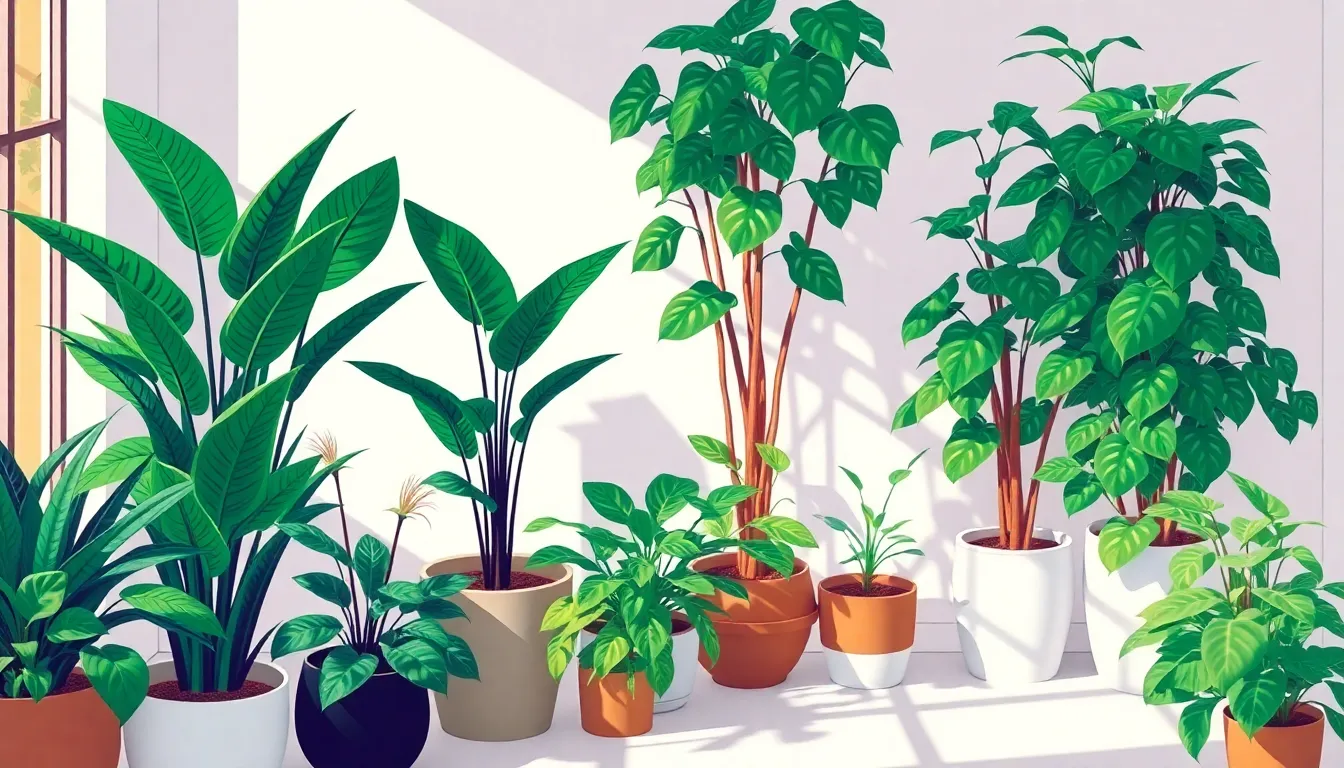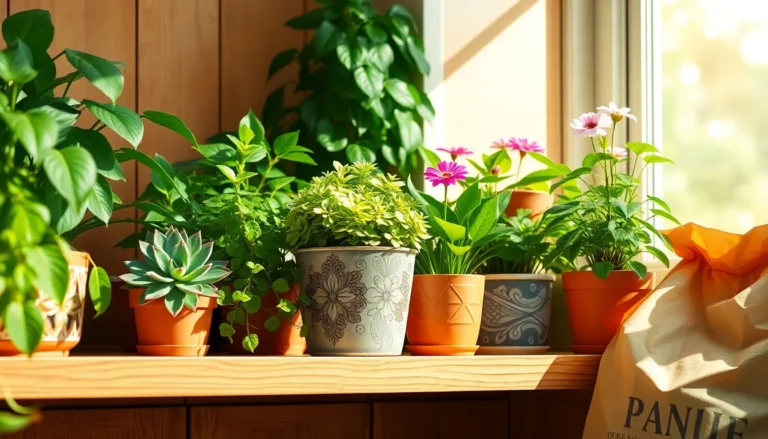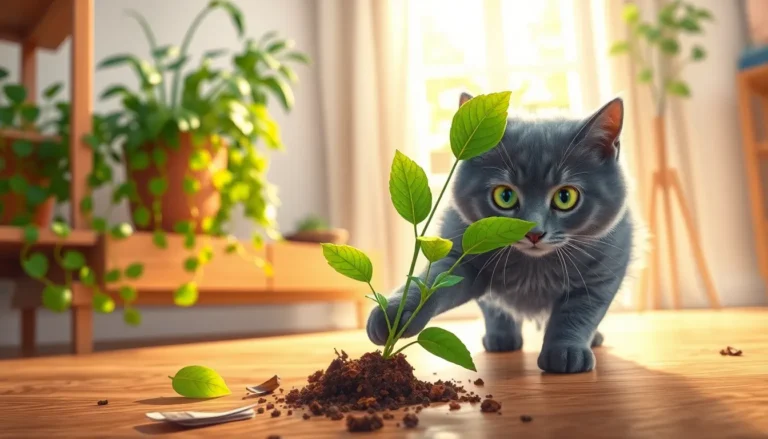Houseplants aren’t just decorations; they’re the green companions that bring life to any space. Imagine a leafy friend that doesn’t judge your Netflix binges or your questionable snack choices. Cool houseplants do just that while purifying the air and boosting your mood. They’re the ultimate low-maintenance roommates—no messy dishes or awkward small talk required.
Cool Houseplants
Cool houseplants refer to unique and trendy plants that stand out due to their appearance, resilience, or ease of care. These plants often feature distinctive shapes, colors, or textures that add flair and personality to indoor spaces. Varieties such as succulents, snake plants, and pothos are particularly popular due to their low maintenance and air-purifying qualities.
Succulents thrive in minimal water and light, making them suitable for both beginners and experienced plant owners. Snake plants, known for their upright leaves, tolerate a range of lighting conditions while contributing to improved air quality. Pothos, with its trailing vines, brings a lush feel to rooms and adapts well to various light settings.
Philodendrons and fiddle leaf figs are also considered cool houseplants. Philodendrons require moderate light and allow flexibility in care routines. Fiddle leaf figs are admired for their large, glossy leaves, making them a favorite for interior decor.
Certain cool houseplants carry specific benefits. For instance, peace lilies bloom with white flowers and filter toxins from the air, enhancing indoor environments. ZZ plants require minimal attention and flourish in low-light areas, making them perfect for busy lifestyles.
Cool houseplants not only beautify spaces but also contribute to overall well-being. Studies indicate that incorporating greenery into homes can reduce stress and promote relaxation. Featuring these plants can transform homes into vibrant, calming sanctuaries.
Benefits of Cool Houseplants

Cool houseplants provide numerous advantages beyond their visual appeal. They significantly enhance indoor environments while promoting health and well-being.
Air Purification
Houseplants like snake plants and peace lilies excel at filtering common indoor toxins. These plants absorb harmful substances such as formaldehyde and benzene, making indoor air healthier. Studies indicate that having houseplants can reduce airborne pollutants by up to 60%. Improved air quality supports respiratory health, making cool houseplants a smart addition for any living or working space. Additionally, they can help maintain humidity levels, which further aids in comfortable breathing.
Aesthetic Appeal
Unique shapes and vibrant colors make cool houseplants visually striking. Varieties such as fiddle leaf figs and pothos can transform ordinary spaces into stunning focal points. Their diverse textures and forms create visual interest, complementing any decor style. Incorporating these plants adds layers and life to interiors, making spaces feel more inviting. They also provide a sense of tranquility, fostering relaxation and enhancing overall mood. Choosing cool houseplants serves as an effective way to beautify any environment.
Top Cool Houseplants to Consider
Cool houseplants offer aesthetic appeal and numerous benefits. Choosing the right plant can elevate any space while promoting health.
Snake Plant
Snake plants stand out for their upright, sword-like leaves. This hardy plant tolerates low light and infrequent watering, making it ideal for busy individuals. Air purification is another benefit, as it filters toxins like formaldehyde and benzene. Placing a snake plant in a corner enhances the room’s visibility while ensuring a fresh atmosphere.
Pothos
Pothos captures attention with its lush, trailing vines. It adapts seamlessly to various light conditions, thriving in both bright and low-light spaces. Low maintenance is essential for many, and this plant requires minimal care. Pothos also purifies air efficiently by removing harmful pollutants. Displaying it in hanging baskets or on shelves adds a charming visual dynamic to any room.
ZZ Plant
ZZ plants enchant with their glossy, dark green leaves. Known for their resilience, they can survive in low-light environments and tolerate neglect. These traits appeal to both novice and seasoned plant enthusiasts. Environmental benefits include air purification and improved indoor humidity levels. Their unique appearance complements any decor style effortlessly.
Monstera Deliciosa
Monstera deliciosa is famous for its large, cut-out leaves. This tropical giant thrives in bright, indirect sunlight, fostering its characteristic growth. Providing humidity enhances its health, appealing to those seeking lush greenery indoors. Besides being easy to care for, monstera contributes to air quality improvement. Its striking visual presence creates a bold statement in living areas.
Tips for Caring for Cool Houseplants
Caring for cool houseplants requires attention to their specific needs. Understanding these requirements ensures vibrant, thriving plants that enhance indoor spaces.
Light Requirements
Plants like snake plants and pothos adapt well to a range of lighting conditions. Bright, indirect sunlight suits them best, but they can tolerate low light. Fiddle leaf figs, however, thrive in bright, filtered light, needing consistent exposure for optimal growth. Native to tropical areas, philodendrons prefer moderate lighting conditions, making them versatile indoor options. Placing plants near windows can maximize their growth potential, but avoiding direct sunlight for sensitive species is essential.
Watering Guidelines
Watering practices vary for different cool houseplants. Succulents require infrequent watering, with their soil needing to dry completely between sessions. Snake plants also prefer this approach, thriving on neglect. Pothos and philodendrons enjoy more moisture and should be watered when the top inch of soil feels dry. Overwatering is the main concern for most plants, potentially leading to root rot. Monitoring and adjusting watering schedules according to each plant’s specific needs supports their health and longevity.
Soil and Fertilization
Well-draining soil enhances the growth of cool houseplants. A mix of potting soil with perlite or sand aids in proper drainage, especially for succulents and snake plants. Fertilization should be done twice a year during the growing season, using a balanced liquid fertilizer to support growth. For philodendrons and pothos, a general-purpose fertilizer provides the necessary nutrients. Observing the plants for signs of nutrient deficiencies helps determine when additional fertilization may be needed. Prioritizing proper soil and fertilization ensures robust, healthy plants that thrive indoors.
Conclusion
Embracing cool houseplants can truly transform any living space into a vibrant oasis. These unique plants not only enhance aesthetics but also contribute significantly to air quality and overall well-being. With their low-maintenance requirements and adaptability, they’re perfect for both novice and experienced plant lovers alike.
By incorporating a variety of these trendy plants, individuals can create a calming environment that promotes relaxation and reduces stress. Whether it’s the striking foliage of a Monstera or the resilience of a snake plant, each option brings its own charm and benefits.
Ultimately, adding cool houseplants to a home is a simple yet impactful way to elevate both the beauty and health of indoor spaces.




